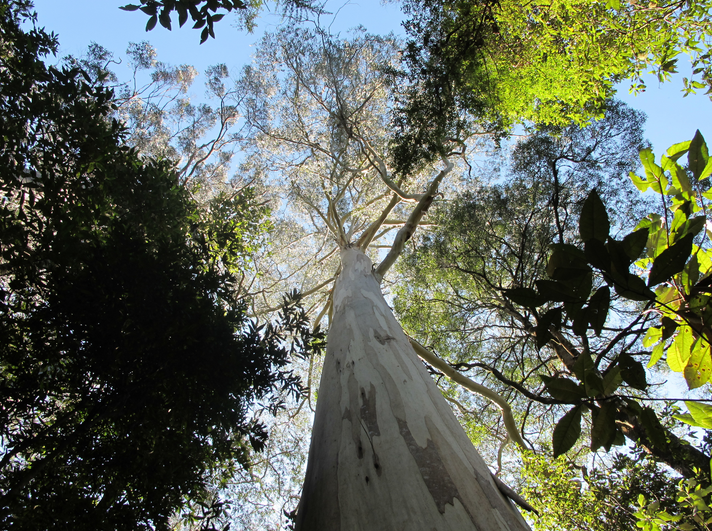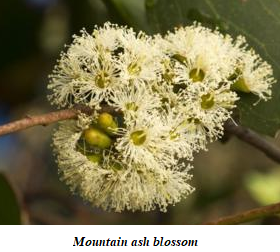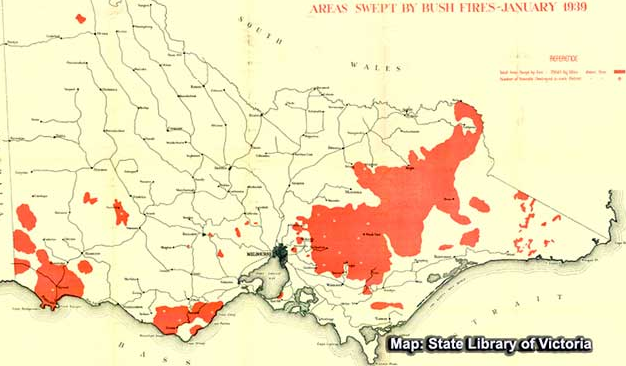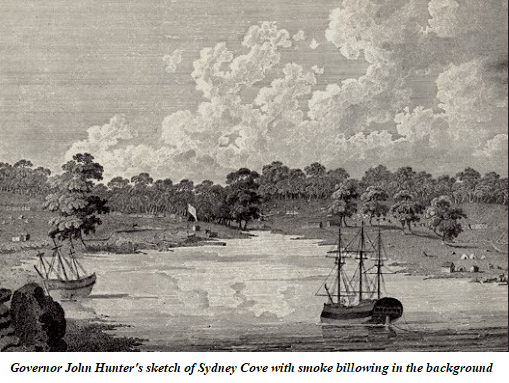
A great mythology seems to prevail in the scientific literature around mountain ash (Eucalyptus regnans), the world’s tallest flowering plant. Victorian foresters have apparently based their silvicultural practices on the idea that mountain ash forests regenerated naturally as even-aged stands after explosive crown-fires. There seems to be a general view that they can only be successfully harvested and regenerated by clearfelling and burning. Ironically, academics opposed to logging have implicitly embraced this view, stating that ash forests remained unburnt for centuries until they were regenerated by stand-destroying holocausts. But climate change and megafires exacerbated by logging are now supposedly driving the forests and their dependent fauna, such as Leadbeater’s possum, to extinction.
Extensive harvesting has allegedly diminished old growth forests and promoted high-intensity fires. In fact, megafires consequent to disruption of Aboriginal burning have converted resilient, open, mixed-aged forests to dense young stands that are sensitive to fire and drought. Harvested areas have been miniscule in proportion. But there’s little hope of resolving the acrimonious debate about forest management whilst the opposing sides each argue from the same false premises — either for the active management of forests, or exclusion of humanity from them. Only an appreciation of ecological history and the critical role of mild burning can guide restoration of healthy, safe and biodiverse landscapes.
ANU environmental historian Tom Griffiths says regeneration of tall ash forests uniquely depends upon firestorms that “crack open their seeds”. This isn’t true. The seed capsules of eucalypts open as they mature and dry out. Maxwell “Doc” Jacobs established in his classic treatise, Growth Habits of the Eucalypts, that seed is mostly dispersed by gravity and wind. Furthermore, reliance upon regeneration directly from seed, rather than progression through a lignotuberous seedling/sucker phase, is not unique to very tall eucalypts that grow on moist and fertile sites. Blackbutt, brown barrel, river red gum, a dryland red gum (named after Sir John See, a former premier of NSW) and Tuart, amongst others, are also non-lignotuberous species. Like mountain ash, they can all grow in woodlands.
Eucalyptus regnans grow as a relatively short and wide-crowned tree in some grassy valleys at low elevations. It was originally called swamp gum in Tasmania. Blackbutt (E. pilularis) also grows in a wide range of topography, soils and climate as a tall straight tree or a short gnarly tree. Its name comes from the fact that its persistent basal bark was invariably blackened by mild fires lit by humans or lightning. Explorers and settlers in southern Australia also called mountain ash “blackbutt”, and they called alpine ash (E. delegatensis) “black gum” or blackbutt for the same reason.
Deputy Surveyor-General Thomas Scott Townsend drove bullocks through subalpine black gum forests in 1846. When he got above the treeline, there was no feed for the bullocks because Aborigines had burnt all the grass during their annual get-together to feast on moths. Townsend had difficulties triangulating his alpine surveys, because the different clans were burning the forests on their various ways home and smoke was “obscuring the horizon in all directions”.
The blacks had visited the Snowy Mountains, a short time previously to us, for the purpose of getting “Bogongs,” … they light large fires, and the consequence was, the country throughout the whole survey was burnt, leaving my bullocks destitute of food. During the time I was on the range the lower parts of the country were burning, and I was prevented, in almost every instance, from getting angles on any distant points, by the dense masses of smoke obscuring the horizon in all directions.
In the 1870s, when European settlers started clearing the great forest of South Gippsland they found three age classes of blackbutt – now called mountain ash: one of “a few very large old trees” and two of dense young regrowth. The younger regrowth was about 20 years old, dating from the Black Thursday megafires of 1851. The older regrowth was about 50 years old. It grew up after the Yowenjerre people were all but wiped out by disease in 1789. Dense and woody understorey spread from deep dark gullies and took over their country. The dense scrub exploded when it was ignited by dry storms in extreme weather around 1820 and eucalypts germinated as thick as hairs on a cat’s back.
When Strzelecki’s party battled through the dense young forest in 1840, he recorded
Sometimes they actually progressed for chains [a chain is a fraction over 20 metres] on top of the scrub by felling some of the tall straight saplings in the direction they were going and scrambling along them.
Strzelecki referred to the unusual red-brown stems of the blackbutts. His party avoided starvation by eating koalas because there were no kangaroos or emus to be had as they struggled for 26 days through 50 miles of dense young forest. No other explorers ever saw koalas.
 Surveyor-General Mitchell wrote: “Fire, grass, kangaroos, and human inhabitants, seem all dependent on each other for existence in Australia ; for any one of these being wanting, the others could no longer continue.” After the demise of the Yowenjerre with their firesticks, the natural system was disrupted, creating dysfunctional and explosive ecosystems dominated by a few irruptive species. A few decades after Black Thursday, Europeans clearing the virgin forest, discovered stone axes and spearheads, grindstones and clay cooking ovens. They recognised that it had been open grassy country with big old trees under Aboriginal management.
Surveyor-General Mitchell wrote: “Fire, grass, kangaroos, and human inhabitants, seem all dependent on each other for existence in Australia ; for any one of these being wanting, the others could no longer continue.” After the demise of the Yowenjerre with their firesticks, the natural system was disrupted, creating dysfunctional and explosive ecosystems dominated by a few irruptive species. A few decades after Black Thursday, Europeans clearing the virgin forest, discovered stone axes and spearheads, grindstones and clay cooking ovens. They recognised that it had been open grassy country with big old trees under Aboriginal management.
Mark Adams and Peter Attiwill suggested that, prior to 1939, much of the Great Dividing Range in Victoria carried about 200 year old, even-aged ash forests regenerated by stand-replacing fires in the early 1700s, when Aborigines were in charge. However, much of the Great Dividing Range must have burnt fiercely in 1851, when megafires raged from the Murray River to Gippsland and burnt about 5 million hectares, roughly a quarter of Victoria. According to David Lindenmayer’s book on Mountain Ash, megafires also burnt ash forests in 1824, 1926, 1932, 1939, 1983, 2003, 2007 and 2009. Less extensive high-intensity fires apparently burnt considerable areas in 1895, 1905, 1908, 1918, 1948, 1962 and 2014.
It seems that wildfires converted old mixed-aged black ash forests into young, mostly even-aged stands of mountain ash or woolybutt (E. delegatensis) after Aboriginal management was disrupted by European diseases or people. Later on, sustainable management was reinstated for a short while. Alpine grazier Harry Treasure, whose family was one of the first into the area, told Stretton’s 1946 Inquiry into forest grazing that mild fires were common around the Dargo High Plains from the 1870s until government restrictions on burning were enforced from about 1910. “Grass was everywhere from the rivers to the mountain tops … It was impossible for a fire to burn far or fierce, and no growing timber was ever destroyed.” The first high intensity fire in his experience wasn’t until 1918. F. Blair, writing around 1950, explains in an unpublished manuscript that damaging fires affected the Bogong High Plains after grazing and burning were restricted. However, some ash forests, illegally burnt by alpine graziers using mild fires to refresh rank grasses, escaped destruction by the catastrophic fires of 1926 and 1939.
Bill Gammage argues in The Biggest Estate on Earth that Aborigines ignited high-intensity stand-replacing fires in mountain ash forests, at long intervals, separated by several human generations, “A winter cool-burn could not ensure enough heat for those wet forests to kill and replace themselves. That needs a dry summer, yet it was done. It must have been a time for brave men, their families safely on the coast.” However, the Black Thursday megafires incinerated ash forests less than two decades after Aboriginal burning was disrupted, and it certainly wasn’t safe on the coast. Embers from a firestorm burnt the rigging of a ship on its way to New Zealand. Aborigines survived without boots or overalls, let alone fire engines and water-bombers, because they used mild fire to manage the whole landscape. Mixed forests and rainforests couldn’t be burnt, because they weren’t receptive to mild fire. They were protected islands in a healthy and safe landscape where extreme fires couldn’t propagate.
Tom Griffiths made a circular argument that “The ecology of the [ash] forest depends on firestorms, so we know they happened also under Aboriginal ecological management”. In fact, firestorms and megafires didn’t happen until after Aboriginal management was disrupted by exotic diseases or European settlement. An unprecedented spike in charcoal deposition during 70,000 years occurred after Europeans arrived, followed by a pronounced decline after foresters reinstated mild burning from the mid-20th Century. Unfortunately it wasn’t generally reinstated in ash forests.
Charcoal in sediment cores is a coarse index of widespread high-intensity burning of woody biomass, i.e. megafires. The late-twentieth century reduction in megafires occurred during a global warming period. After prescribed burning was reduced and megafires became rampant again, Griffiths was “horrified” by the “familiarity of the Black Saturday firestorm”. He wrote that “The event was clearly exacerbated by climate change, but the recurrent realities were more haunting. As I wrote at the time, the 2009 bushfires were 1939 all over again”.
However, Black Friday 1939 clearly demonstrated that megafires are driven by accumulation of fuel, not climate change. Despite the extreme weather conditions, many fires in East Gippsland caused little damage. Victoria’s Forests Commission had attempted to suppress fire in the mountain ash and woolybutt (alpine ash) forests, whilst the low and mid-elevation forests east of the Snowy River were mostly controlled by the Lands Department and routinely burnt by graziers, keeping them open, healthy and safe.
John Mulligan was there as a young lad. His family wasn’t worried, even when his uncle’s car repeatedly stopped because of vapour locks in the fuel lines with the extreme heat. A map of the 1939 fires in Victoria (below) shows a stark contrast. A million hectares of unbroken fire extended from the Murray River north of Corryong and southwesterly along the Great Dividing Range to Melbourne. The 14 large fires in far East Gippsland were disaggregated and small in proportion.

A profusion of megafires in the New Millennium consequent to reduced burning has not yet been measured as charcoal in sediment cores. Nevertheless, it has been publicised worldwide as an alleged consequence of climate change. The Washington Post pictured dense black smoke billowing from the recent Gospers Mountain conflagration (northwest of Sydney) under a headline of “record heat wave and catastrophic fire danger”. This megafire, ignited by lightning and fuelled by explosive fuels in unmanaged wilderness, set its own record as the largest-ever – more than half a million hectares – from a single ignition.
But history clearly shows us that catastrophic fires are a direct consequence of suppression of mild burning by authorities with wilderness between their ears. The alleged record heat wave of December 2019 was by no means unprecedented. For example, during the Settlement Drought, in the early 1790s, Aboriginal fires were constantly burning in what is now wilderness to the northwest of Sydney. In December 1790, dry northwesterly gales, “like the blast from a heated oven”, didn’t drive the fires into the European settlements on the Cumberland Plain, even though the temperature on the Parramatta River was 430C. In 1791, Watkin Tench reported an even more extreme heatwave:
But even this heat was judged to be far exceeded in the latter end of the following February, when the north-west wind again set in, and blew with a great violence for three days. … at Rose Hill [now Parramatta], it was allowed, by every person, to surpass all that they had before felt, either there, or in any other part of the world. … An immense flight of bats, driven before the wind, covered all the trees around the settlement, whence they every moment dropped dead, or in a dying state, unable longer to endure the burning state of the atmosphere. Nor did the perroquettes, though tropical birds, bear it better; the ground was strewed with them in the same condition as the bats.
Were I asked the cause of this intolerable heat, I should not hesitate to pronounce, that it was occasioned by the wind blowing over immense deserts, which, I doubt not, exist in a north-west direction from Port Jackson, and not from fires kindled by the natives.
Tench was spot on, as the Bureau of Meteorology confirmed much later. The thing is that, despite the extreme weather, the natives’ fires didn’t reach the European settlements. A year later, in 1792, the country was still gripped by drought and Aborigines were still burning. This time fires burnt into the European settlements, but they were not uncontrollable firestorms because they were burning in light and discontinuous fuels. On December 5, 1792, a grass fire at Sydney burnt one house and several gardens and fences before being controlled. On the same day Judge Advocate David Collins wrote:
At Parramatta and Toongabbe also the heat was extreme; the country there too was everywhere in flames. Mr. Arndell was a great sufferer by it. The fire had spread to his farm; but by the efforts of his own people and the neighbouring settlers it was got under, and its progress supposed to be effectually checked, when an unlucky spark from a tree, which had been on fire to the topmost branch, flying upon the thatch of the hut where his people lived, it blazed out; the hut with all the outbuildings, and thirty bushels of wheat, just got into a stack, were in a few minutes destroyed.
Nowadays, during extreme weather, firestorms inevitably explode in three-dimensionally continuous fuels in the wilderness and often roar into suburbs. Despite the title of the latest Royal Commission into bushfires, they are not natural disasters. They cannot occur in healthy landscapes maintained by frequent mild burning. Nevertheless, the myth persists that extensive even-aged ash forests are natural systems which need crown-fires to regenerate them. Ecologists call them wet sclerophyll forests. This is an ill-defined term, mostly referring to forests that have developed tall, dense scrubby understories as a consequence of lack of mild burning.
Some 130 years ago, Alfred Howitt deduced that tall dense shrubs invaded ash forests after the demise of Aboriginal people. More than half a century ago, T.M. Cunningham and K.W. Cremer reported a similar process in Tasmania. They distinguished mixed forests with rainforest subcanopies from naturally open forests invaded by the same tall shrubs that Howitt had identified. Cunningham and Cremer called them wet “sclerophyll understoreys”. Now these unnatural ecosystems are confused with mixed forests. However, mixed forests are truly wet sclerophyll forests because they can only grow where it is consistently wet enough for rainforest trees to develop. They occur in small isolated stands near the edge of rainforests on fertile, well-structured soils with small upslope catchments. Unlike rainforests, they are accessible to fires on a centennial timescale, when major droughts dry out watertables and make leaf and bark litter suspended in the canopy and accumulated at the base of eucalypts unusually flammable.
Unlike many rainforest fruits, eucalypt seeds are tiny and dry. To germinate and establish, they need sunshine, fresh air and contact with moist mineral soil so that seedling leaves can start to make food whilst primordial roots start to extract moisture from the soil. Eucalypt seedlings cannot establish under rainforest. They establish naturally in mixed forests after the rainforest subcanopy is destroyed by intense fire. This needn’t be a megafire, nor does it necessarily replace the old eucalypt stratum. For example, there are some small pockets of mixed forest near Urbenville in northern NSW, where
The chief vegetation types are rain forest and tall woodland. …The sedimentary areas are largely covered by Eucalyptus-dominated tall woodland. Many species of eucalypt are present … In places there is an understorey of smaller trees, particularly Casuarina torulosa and Acacia spp.. The ground stratum consists chiefly of grasses. … Some small areas of wet sclerophyll forest, usually dominated by blue gum (Eucalyptus saligna), are found chiefly on the edge of some rainforest [on basalt soils]. The boundary between rain forest and woodland is usually sharp.
— CSIRO scientist J.H. Calaby
There is a hectare or so of Sydney blue gum over subtropical rainforest near Tooloom Lookout. On its western side is mature mixed-aged grassy woodland. On the eastern side is mature subtropical rainforest. The small stand of blue-gum mixed forest has two age classes of blue gum. The younger blue gums appear to date from the Federation Drought, when a moderate fire in the woodland apparently ignited the unusually dry accumulation of eucalypt fuel in the mixed forest. Despite the extreme drought, the wildfire didn’t penetrate the ancient rainforest.
Mixed forests of mountain ash over temperate rainforest are more likely to be even-aged because mountain ash is more sensitive than blue gum to the hot fires that are necessary to destroy rainforest subcanopies. Wood and colleagues described one such stand at the slightly exposed fringes of a rainforest plateau in southern Tasmania. It was 400 years old, the mountain ash and rainforest trees regenerated by a stand replacing fire about 1500 AD.

Mixed forests can only occur in fire-exposed niches at the edge of rainforests where they regenerate after very infrequent moderate to high intensity fires. If the eucalypt canopy comprises a single species, such as mountain ash, that is relatively sensitive to intense fire, it may be the same age as the rainforest subcanopy. The flammability of mixed forests is governed by drought rather than the volatility of foliage. At least one of the temperate rainforest species that are supposed to inhibit fire in the subcanopy of mixed mountain ash forests – sassafras – has volatile leaf oils that explode in crown-fires.
David Lindenmayer, Professor of Ecology and Conservation Biology at the Fenner School of Environment and Society at the Australian National University, is regarded as an expert on Victorian ash forests. Over three decades he has carried out extensive research and published, on average, 28 scientific papers and books per year. After the catastrophic 2019-20 fires, Lindenmayer and colleagues argued that their severity was unprecedented due to “climate change” and “major logging-generated changes … such as the creation of extensive areas of young even-aged stands characterized by densely stocked trees”. These changes supposedly caused fires to burn into old growth forests.
I don’t profess to be an expert on mountain ash, but I have difficulty reconciling these arguments with history.
Vic Jurskis, a veteran forester and fire expert, is the author of the just-published “The Great Koala Scam: green propaganda, junk science, government waste & cruelty to animals”. It can be ordered here
 Sign In
Sign In 0 Items (
0 Items ( Search
Search









Elizabeth Beare, Michael’s wife
A very interesting read, Vic. I grew up in outer Western Sydney in the 1940’s and 50’s. The area was only sparsely wooded and contained much open pasture and grassland. It was always stinking hot in summer.
It now has more trees planted out on it amongst the suburban development I suspect than ever existed there before under aboriginal or pastoral management. Further over to the south were the ‘cow pastures’, which nourished six cows escaped from the first fleet into a fine wild herd.
The message about Australia’s treed landscape needs to go out; it was burned into existence and its fairly stable ecology was human maintained. It is now substantially out of control.
I observed a good regeneration of stringybarks after a burnoff at Duffy’s Forest north of Sydney a few years ago,unfortunately the swamp wallabies were observant as well and nibbled up everything in sight, ah well the best laid plans can go astray. A good article and I would have to agree, excessive fuel loads are the problem in wildfires, climate change i.e. drought has been with us since the ice age.
Those tropical “Peroquettes” that dropped dead by the thousands in Feb 1791 are still quite plentiful yet I have never seen that happen in my lifetime.
Could it have been hotter in 1791 than today?
But yes, mild burns need to be carried out as often as possible even though the purpose of aboriginal burning was mainly to reduce rain forest which they could not live or hunt in.